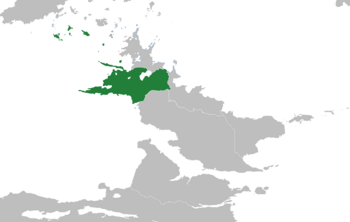Alforja: Difference between revisions
mNo edit summary |
|||
| Line 157: | Line 157: | ||
The Riots In Llayola had turned into open revolt by 1901. General '''Adalbert Bajona''' had been sent to the city to put down the rebellion and by the end of the year 18,000 people had been killed. Bajona’s rampage of terror had reached the Government in Rodonya who ordered him to be taken into custody immediately. Upon learning of the news troops Loyal to Bajona turned against the Government and a state of Emergency was declared. Small skirmishes and battles took place nationally but by the end of January Bajona announced to the nation that he would be taking the office of President until the situation has subsided. The former Government fled to Vidoria and set up a Government in Exile. Federal Elections were called for July of 1902. The Military took the supermajority of the seats and began changing the constitution. The Muntagne was suspended in September and Bajona’s Clique became even more Dictatorial. In early 1903 Vidoria stepped up it’s claim on various Alforjan territories and the first shots were fired over the Border on 12th of May, 1903 beginning the [[Alforjo-Vidoria War]]. | The Riots In Llayola had turned into open revolt by 1901. General '''Adalbert Bajona''' had been sent to the city to put down the rebellion and by the end of the year 18,000 people had been killed. Bajona’s rampage of terror had reached the Government in Rodonya who ordered him to be taken into custody immediately. Upon learning of the news troops Loyal to Bajona turned against the Government and a state of Emergency was declared. Small skirmishes and battles took place nationally but by the end of January Bajona announced to the nation that he would be taking the office of President until the situation has subsided. The former Government fled to Vidoria and set up a Government in Exile. Federal Elections were called for July of 1902. The Military took the supermajority of the seats and began changing the constitution. The Muntagne was suspended in September and Bajona’s Clique became even more Dictatorial. In early 1903 Vidoria stepped up it’s claim on various Alforjan territories and the first shots were fired over the Border on 12th of May, 1903 beginning the [[Alforjo-Vidoria War]]. | ||
General Adalbert Bajona was ousted as the war ended in a Stalemate ending the [[First Alforjan Republic|First Alforjan Republic]]. | General Adalbert Bajona was ousted as the war ended in a Stalemate ending the [[First Alforjan Republic|First Alforjan Republic]]. The Second Republic of Alforja (1905-1950) was characterised by the Rise and Fall of the [[Party of the Socialist Workers (Alforja)|Party of the Socialist Workers (Alforja]] ({{wpl|Catalan Language|Alforgenc}}: Partit dels treballadors socialistes.) The Second Republic ended following the Constitutional crisis of 1950. The Council system which had prevailed in Alforja gave way to a new Presidency championed by '''Esteve Algué'''. The Presidency allowed Algué to grant Federal Powers to the Provinces. | ||
The '''Juia Agreement''' Signed In 1964 between Algué who had entered his third term as President gave rights to the Provinces of Juia and Llayola and the option to hold a referendum to secede once the majority of the population agreed. This ended the JLLA’s bombing campaign across Alforja. | |||
Since the '''1982 Creixell Bombings''' and more recently the '''2015 Valles Attack''', Alforja has been targeted by Radical Seperatists seeking to recreate the Terror in Llayola and Juia to properly secede from the Federation most notably the Front d'Alliberament de Caiya or Caiya Liberation Front. | |||
== Geography == | == Geography == | ||
Revision as of 17:35, 7 July 2019
This article is incomplete because it is pending further input from participants, or it is a work-in-progress by one author. Please comment on this article's talk page to share your input, comments and questions. Note: To contribute to this article, you may need to seek help from the author(s) of this page. |
Virtuous Republic of Alforja República Virtuosa de Alforja | |
|---|---|
|
Flag | |
| Motto: Aixequeu-vos tots els Alforjans | |
| Anthem: Himne nacional de Alforja
| |
 | |
| Capital and | Rodonya |
| Official languages | Alforjac |
| Ethnic groups (2015) | White (45.2%) Black (31.9%) Native Rennekans (14.7%) Others (8.18%) |
| Religion (2015) | x |
| Demonym(s) | Alforgenc |
| Government | Federal Semi-Presidential Republic |
| Luis Seguí | |
| Àgata Novoa | |
| Guifré Sarro | |
| Legislature | Muntatge |
| Senat | |
| Assemblea popular | |
| Establishment | |
| 1517 | |
• Establishment of the Alforjan State | 1609 |
• Alforjan Revolution | 1833 |
| Population | |
• 2019 estimate | 40.337 Million |
• 2015 census | 39.989 Million |
| GDP (PPP) | 2019 estimate |
• Total | $1.344 Trillion |
• Per capita | $32,227 |
| GDP (nominal) | 2019 estimate |
• Total | $1.277 Trillion |
• Per capita | $31,658 |
| Gini (2015) | 30.7 medium |
| HDI | very high |
| Currency | Orzon (AOZ) |
| Time zone | -6 -8 |
| Date format | dd-mm-yyyy |
| Driving side | right |
| Calling code | +101 |
| Internet TLD | .AJ |
Alforja (Alforjac: Alforja) officially the Virtuous Republic of Alforja (Alforjac: República virtuosa d'Alforja), is a federal republic on the the continent of Rennekka, located within Aeia. The country is bordered to the west by the Jade Ocean to the East by the Opal Ocean, to the North by Eshuani and to the south by Vidoria and x. Alforja's territory also stretches into Vestrim with it's Island States.
With an Area of 3,873,811 km², Alforja is the largest nation on the Continent of Rennekka followed by Renneque. Despite this vast quantities of Alforja's land area are covered in Rainforests with the Largest being the Rossel which splits the country into two Sections.
Little is known about Alforja before it was colonised by Ardaima with various Groups, the largest being the Ataxa people in the State of X. Historically the Ataxa straddled the West Coast of Rennekka with remnants of their Empire being found in Renneque.
Alforja was first settled by Asurans in X, initially by the West Rennekka Company and then Ardaiman East Rennekka. The land was settled initially by ethnic Alforgencs who had been denied a State in Asura and were frequently oppressed. The leader of Ardaima at the time had thought the expulsion of the Alforgencs would stop their eventual Massacre.
Alforja gained independence in 1643 following a series of Revolts and the unpopular decision to give the Eastern Coast of Alforja to Cuirpthe for their own colonial holdings. The Capital was moved to Rodonya in 1822 and in the mid 18th century Alforja annexed a group of Islands in the South Columbian Sea beginning a series of Militant Wars and Revolts.
Alforja intervened in the First Great War seizing and Annexing the Cuirpthean Colonial holdings on mainland Rennekka.
Etymology
Alforja derives off the Fiorentine Averta which translates in Alforgenc to Saddlebag. The unusual name was created by the first settlers of Alforja and named it after the bags that carried supplies with them on their expeditions. The name was first officially used in 1844 when it had to be decided what the prefix of the Alforja should be. At the time sitting Muntagne President Fructuós Llesera proclaimed the nation to be Republica de Alforja which translates into Republic of Alforja.
History
Prehistoric
Ataxian Empire
East Rennekka Company
Independence
Industrial Alforja
Modern Age
The Riots In Llayola had turned into open revolt by 1901. General Adalbert Bajona had been sent to the city to put down the rebellion and by the end of the year 18,000 people had been killed. Bajona’s rampage of terror had reached the Government in Rodonya who ordered him to be taken into custody immediately. Upon learning of the news troops Loyal to Bajona turned against the Government and a state of Emergency was declared. Small skirmishes and battles took place nationally but by the end of January Bajona announced to the nation that he would be taking the office of President until the situation has subsided. The former Government fled to Vidoria and set up a Government in Exile. Federal Elections were called for July of 1902. The Military took the supermajority of the seats and began changing the constitution. The Muntagne was suspended in September and Bajona’s Clique became even more Dictatorial. In early 1903 Vidoria stepped up it’s claim on various Alforjan territories and the first shots were fired over the Border on 12th of May, 1903 beginning the Alforjo-Vidoria War.
General Adalbert Bajona was ousted as the war ended in a Stalemate ending the First Alforjan Republic. The Second Republic of Alforja (1905-1950) was characterised by the Rise and Fall of the Party of the Socialist Workers (Alforja (Alforgenc: Partit dels treballadors socialistes.) The Second Republic ended following the Constitutional crisis of 1950. The Council system which had prevailed in Alforja gave way to a new Presidency championed by Esteve Algué. The Presidency allowed Algué to grant Federal Powers to the Provinces.
The Juia Agreement Signed In 1964 between Algué who had entered his third term as President gave rights to the Provinces of Juia and Llayola and the option to hold a referendum to secede once the majority of the population agreed. This ended the JLLA’s bombing campaign across Alforja.
Since the 1982 Creixell Bombings and more recently the 2015 Valles Attack, Alforja has been targeted by Radical Seperatists seeking to recreate the Terror in Llayola and Juia to properly secede from the Federation most notably the Front d'Alliberament de Caiya or Caiya Liberation Front.
Geography
Climate
Biodiversity
Urbanisation
Politics

|

|
| Luis Seguí President |
Àgata Novoa Prime Minister |
